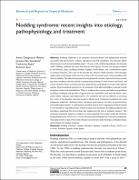| dc.contributor.author | Mwaka, Amos Deogratius | |
| dc.contributor.author | Semakula, Roy Jerome | |
| dc.contributor.author | Abbo, Catherine | |
| dc.contributor.author | Idro, Richard | |
| dc.date.accessioned | 2021-04-28T14:33:33Z | |
| dc.date.available | 2021-04-28T14:33:33Z | |
| dc.date.issued | 2018-05-24 | |
| dc.identifier.citation | Mwaka, A.D., Semakula, J.R., Abbo, C. and Idro, R., 2018. Nodding syndrome: recent insights into etiology, pathophysiology, and treatment. Research and reports in tropical medicine, 9, p.89. | en_US |
| dc.identifier.issn | 1179-7282 | |
| dc.identifier.uri | http://hdl.handle.net/20.500.12280/2777 | |
| dc.description.abstract | Nodding syndrome is an enigmatic neuropsychiatric and epileptiform disorder associated with psychomotor, mental, and physical growth retardation. The disorder affects otherwise previously normal children aged 3–18 years, with a slight preponderance for the male child. Nodding syndrome has been described in rural regions of some low-income countries in sub-Saharan Africa including northern Uganda, South Sudan, and a mountainous region of southern Tanzania. The cause of the disorder has hitherto eluded scientists. Neuroimaging studies show involvement of the nervous system with associated severe cortical atrophy in the affected children. The affected communities have generated a number of perceived causes including some conspiracy theories related to intentional poisoning of water sources and foods, and causes related to fumes and chemicals from ammunitions used during civil wars in the affected regions. From biomedical perspectives, the treatment of the affected children is geared towards symptoms control and rehabilitation. There is evidence that seizures and behavioral problems including wandering and episodes of aggressions are controllable with anticonvulsants, especially sodium valproate and antipsychotics. No treatments have proven effective in reversing the course of the disorder, and cure remains a distant goal. Community members have used indigenous medicines, cleansing rituals, and prayer interventions, but have not perceived any reasonable improvements. A randomized controlled clinical trial is ongoing in northern Uganda to test the efficacy and effectiveness of doxycycline in the treatment of nodding syndrome. The hypothesis underlying the doxycycline trial underscores the role of antigenic mimicry: that antibodies generated against an antigen of a microorganism that resides inside the black fly-transmitted parasite, Onchocerca volvulus becomes directed against nervous tissue in the brain. This paper reviews some of the recent advances in researches on the etiologies, pathophysiology, and treatment of nodding syndrome. | en_US |
| dc.language.iso | en | en_US |
| dc.publisher | Dove press Ltd | en_US |
| dc.relation.ispartofseries | Research and reports in tropical medicine;9 | |
| dc.subject | Nodding syndrome | en_US |
| dc.subject | Epilepsy disorders | en_US |
| dc.subject | Epilepsy | en_US |
| dc.subject | Conspiracy theory | en_US |
| dc.subject | Onchocerca volvulus | en_US |
| dc.subject | Northern Uganda | en_US |
| dc.subject | South Sudan | en_US |
| dc.title | Nodding Syndrome: Recent Insights into Etiology, Pathophysiology, and Treatment | en_US |
| dc.type | Article | en_US |


